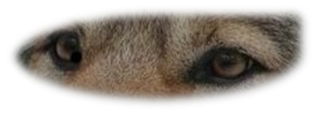Alaskan Malamute
Origin / History
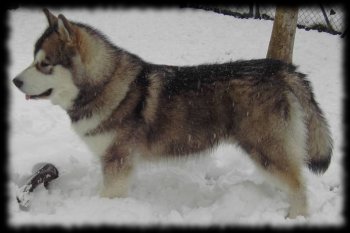
The current Malamute is a product of its historic origin. Its ancestors came during the last ice age with the ancestors of the Inuit's-people, which are living in the arctic regions of North America and Greenland, over the Bering Strait from Siberia to Alaska.
The origin of these arctic native goes back many millenniums and is widest being a matter of reflection of the different and strongly changing climatological conditions to which they have always adapted themselves.
Because these people knew no writing and till the 18th century also did not have any contact with outstanding persons, their past is a perpetual jigsaw puzzle which should be solved with the help of archaeologists, linguists, Paleontolists and Antrhopologists.
The native owed the success in the survival to own, technical achievements, as for example harpoons or kayaks which have extended the food pallet as well as their aimed use of dogs to them. The ancestors of the modern huskies, the Nordic type which accompanied the ancestors of the Inuits on their journeys represent a very old dog's type which already lived for a long time to work for the people.
The next, natural improvement of their life brought the development of the sleighs with which, e.g., foods could be transported much more simply. Till the middle of the 19th century the Inuits have maintained the lifestyle and the hunt connected more or less same. Then they had to issue some intervention in their life which has changed this likely for good.
Up to short time a mutual dependence consisted between person and dog in the Arctic. If a walrus was shot, up to a metric ton of meat had to be transported for which then naturally the dogs were demanded. On the other side the demands of the dogs to the food amount raised the burden of some family, so they saved the dogs life with a minimum in food before starving.
If the food allowed to, then the Inuits held some dogs required for pulling the sleigh. This was necessary, because also dogs can be ill or bitches could become pregnant. Such dogs were not able to pull the big weights any more.
The number of the required dogs depended on different factors, as for example number of the healthy dogs, offspring of the dogs, road distance, depth and state of the snow, the weather. If the load was too big, the Inuits also helped their dogs pulling the sleighs. For the Inuits the dogs in the rough Arctic therefore very often represented the difference between life and death.
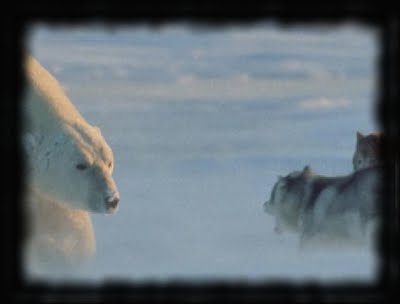
So that their dogs could not bite to pieces the train tableware or the hauling cables which were manufactured from longing or leather, many families pulled the dog's teeth or filed them off. Filed off or pulled teeth decreased the risk of a hurt, on the one hand among the dogs during fighting, but also with the people who were bitten of the dogs. Because the dogs could not chew their food, the Inuits fed them either on small pieces of meat or on walrus's skin which were completely bolted down by the dogs. The Inuits believed that unchewed food remained longer undigested and so the dogs would remain filled for a longer time.
Convinces as the fact that hungry dogs would be the better workers, they fed them only every 2nd day, with productivity even only every 3rd day. If the food was scarce, the Inuits informed Arctic discoverers, one can invest the dogs even up to 5 days without fodder. Then, however, they died very often very quickly on weakness.
Discoverer, which took over the natural manner of the Inuits to match themselves against the arctic climate, carried on with these feeding practices till 20th century. The wildness characteristing the huskies, particularly what the fodder concerns, has to do undoubtedly more with the constant hunger than with an innate, malicious temperament.
Many people castrated all their dogs, out of the leading dogs. This guaranteed that the bitches were paired only with the best dogs and that there were less rival's battles for the bitches.
However, the dogs were applied not only for the sleigh-pulling, they also helped in the hunt, while they hunted up air bubbles of seals snapping at air. They were also used for the hunt for the most dangerous robber, the big bears.
Although within the Arctic the dogs of the Inuits were very similar, bigger differences resulted out of the regulation of work which had to be done by the dogs, the geographic position as well as the amount and the sort of the snow. In the far northwest of Siberia, the smaller and lighter built dog of the Chukchi, which is known to us as Sibirian-Husky, became very famous, because of its big mobility and its speed. The Chukchi were hunter and furrier which used the dogs for the long transportations to the commercial centres. Their dogs pulled less weight per dog, but at a bigger speed than those of the Alaskan coast hunter. If the weight was too big for a team, simply different teams were formed and the weight were distributed to the different sleighs.
On the other side of the earth there were the dogs of the Greenland Eskimos. These dogs are bigger than the Sibirian-Husky and worked in the infinite width of the frozen island on which pack-ice represent a dangerous working territory. Greenland dogs had to pull bigger weights and lived under roughest conditions. These dogs were untiring, willing workers, but very much aggressive. For Arctic explorers these dogs represented the favorites for their expeditions, that is why it has also brought both to the Poles.
Basis of the Alaskan Malamute
The basis for the current Alaskan Malamute formed the big, strong dog of the Malemute (Mahlamuits or Mahlemuts). This Inuit's-people inhabited the region around the Kotzebue-Sound in Alaska and hunted and fished like other coast-Inuits. The Malemutes knew the value of their fine animals which were called as very beautiful and from infinite perseverance. The Malamute is much bigger than a Sibirian-Husky and a little bit bigger than a Greenland dog, fitted with a special fur, a tendency towards to more regular drawings and less variations in color. Because of their appearance similar to wolf, they very often were named as "Wolfdog".
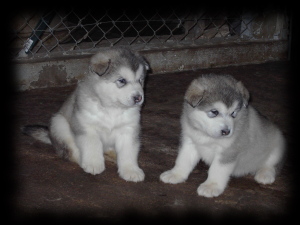
Although the ways of wolves and dogs have separated already much earlier than the dog has moved togehter with the people, arctic dogs have a nearer relationship to the wolf than other dogs. The practice, to castrate a dog or the death of a potent dog could bring the breeding in serious danger. Then this could be compensated only with dogs beyond own breeding.
Another possibility consisted in crossing dogs with wolves. To wolf-hybrid can be very unpredictable, only the most similar to dog ones were applied for further breeding. The nearer such a hybrid came to a wolf, the less he would be suitable as a working dog. To get an effective working dog, the genetic composition had to be diluted so rapidly as possible with such of dogs. A lot of generations were necessary to become the Malamutes a good husky: build and head building, fur, cooperation, obedience to an alpha-animal, incredible force and perseverance. While this applies also to the wolf, nevertheless, only the Malamute can be trained, is a willing and enthusiastic worker, as well as lovingly and confidently which certainly are not wolf characteristics.
The fur of the Nordic dogs and the wolves is a little bit different. For the wolf, also an arctic inhabitant, it is less suitable for the merciless work in freezing temperatures.
The huskies who were applied for expeditions in both pole areas were able to accomplish incredible performances. The main criterion for the breeding was the survival what was not very simple with such deep temperatures. To form a little bit more difficultly everything, both, dogs and people, had to exist against the dangerous hunters of the Arctic. Under these circumstances it was not in the growers to determine the best qualities of a dog for the breeding, it was completely the nature which met the necessary decisions. Only the best and strongest dogs could survive it, even if there was only a minimum in food available.
To come to the necessary food, these dogs had to construct a Teamwork, on the one hand with the other dogs and on the other hand with the people who have worked together with the dogs. Droppings of food from aeroplanes were possible only after the 2nd world war, so that the Arctic explorers had to take all required food from home. The dogs were supplied only with the most necessary food, so that as little as possible had to be carried along. The difference between survival and death only was that one had enough dogs.
The same differences how they appear between Greenland Eskimo dogs and the Siberian Huskies, are considered in a smaller degree also to the dogs of the arctic territories of the USA and Canada. The country, the type and the amount of the snow, the tasks, on the dogs approached resulted in differences in the length of the fur, the length of the legs and the substance of the dogs. Small differences for an outsider, certainly, but the differences which characterize the separate races and which within the same breeding remain. This, because the separate people and with it the separate breeds had more or less no contact to each other.
Reports, as for example that of Corbett, confirm that the Inuits of the Bering Sound had certain types of dog, named Malamutes. Other ethnic groups had of course their own type of husky. The miners (at the moment of the Goldrushes) and adventurers, of course, did not bother about the peculiarity and differences of the separate races. Today that's why practically no documents about the seprate breeds exist nor about their differences and comparisons.
The outsiders who came to this region likely began to name all huskies simply Malamutes, in spite of their origin. To produce around the whole thing a little bit more to confusion, the dogs from the north of the American Arctic were called Newfundland Huskies, Manitoba Huskies, Eskimos, Malamutes or Malemutes, Mackenzie River Dogs and many things more. Because the miners took the different races in the whole region there and so the different breeds were confronted with exterior influences, today it is difficult to exactly define the origin of the separate breeds. The arising popularity for husky running, however, accelerated these problems still even more.
In 1908 Nome Kennel club was founded and therefore the annual all-Alaska Sweepstakes runnings with a 408 miles long course was initiated. Other Kennel clubs followed and organized their own runnings. Overnight winners became heros. Bigger sums in money changed the hands, as victory premiums as well as from bets. In Alaska a new fever raged after the Goldrush. Each, also practically inexperienced, tried to put together his own bottom plate in huskies to be able to cut off a piece from the big money cake also. Now the dogs which have been brought from the outside world to Alaska were applied suddenly in the existing breeds to allow to get the separate dog's breeds becoming faster.
The birth of the current Alaskan Malamute
The preservation of the working huskies became more difficult, because on account of the progressive technology now suddenly snowmobiles took over their tasks. An Alaskan Malamute, as well as we know him, in a running against this technology had a difficult state, would be lost even on the contrary. 1909 till 1918 were therefore the probably blackest time for the Alaskan dogs. Many of the excellent breeds were sacrificed to the breeding by much faster dogs.
Breeding practices of this time assure that out of other, real or cross-bred dogs the current race of the Alaskan Malamute has appeared. What dogs this exactly were, today can only be conjectured.
The genetic dominance of the Nordic dogs made the presence of dogs from the outside world or wolves a big subject for debate. The influence of inbred dog's races as for example the mastiff's-type like the St. Bernhard, hats dogs like the German shepherd, sporting dogs like the Irish English setter, would have disappeared probably very quick, one would have brought back the so reached crossings again to the northern regions.
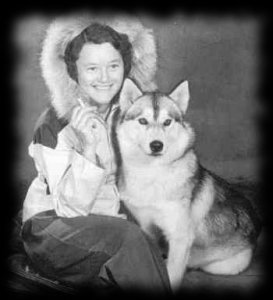
The Malamutes which found the current race had undoubtedly some progenitors from the "Lower 48". Their pedigree, so far confesses, contains possibly also a wolf. These dogs likely reached the outside world directly from the teams of the Inuits. Therefore these dogs emigrated gradually about different ways in the most different countries. Their descendants thereby became the race of the Alaskan Malamute known today.
While to the preparations to the expedition of admiral Richard E. Byrd some dogs were brought to Chinook. In this time 2 dogs were presented to Eva "Short" Seeley by Alan Alexander "Scotty Allen" which were larger than Sibirian Huskies. This are the dogs who should embody the big husky of Alaska. Vandal, one of these dogs, attained the attention of Eva Seeley, although its name described just the Character of this dog. The Byrd-expedition still took some dogs which resembled vandal what the Seeleys allowed to suppose, that these dogs exist as a group if not even as a race.
Eva Seeley was fascinated by the big dogs whose gentle temperament did not really fit the appearance similar to wolf. With the image of these both dogs the idea of the race Alaskan Malamutes was born. Jad and Bessie were applied in 1929 for the first pure Alaskan Malamute breeding. Four boys saw themselves very similarly and were named Tugg of Yukon, Gripp of Yukon, Finn of Yukon and Kearsarge of Yukon. Tugg got lost and Kearsarge died during the 2nd Antarctic-expedition. Gripp of Yukon became the first Alaskan Malamute champion. He was no real dog for exhibitions, but an use dog and in 1924 the leading dog of her team on the occasion of the Olympic games of Lake Placid where a husky running was delivered as a demonstration contest.
Nancy Russel of the Storm Kloud Kennel decided in 1994 that it is time that the Alaskan Malamutes returned to the Iditarod. Her team which was led by Jamie Nelson was in the best constitution which retained it with an essentially smaller calorie admission than the other races. The Malamutes weighed between 25 and 40.7 kg, many of them were champions. During the running they reached an average of 80 miles (= 128.72 km) per day, and this in the hardest part of the running. In the half time of the running the Malamutes had the highest part in still running dogs of all teams. However, after 654 miles the team had to give up because of foot problems.
© Alaskan-Malamute.ch

